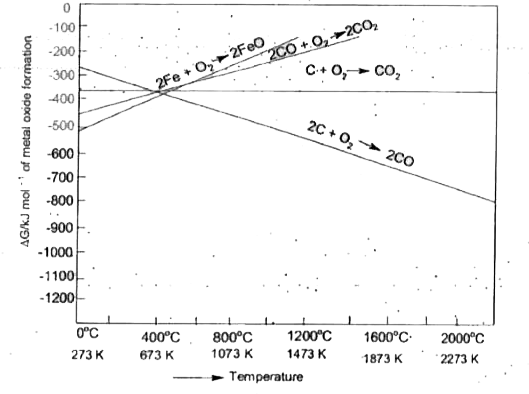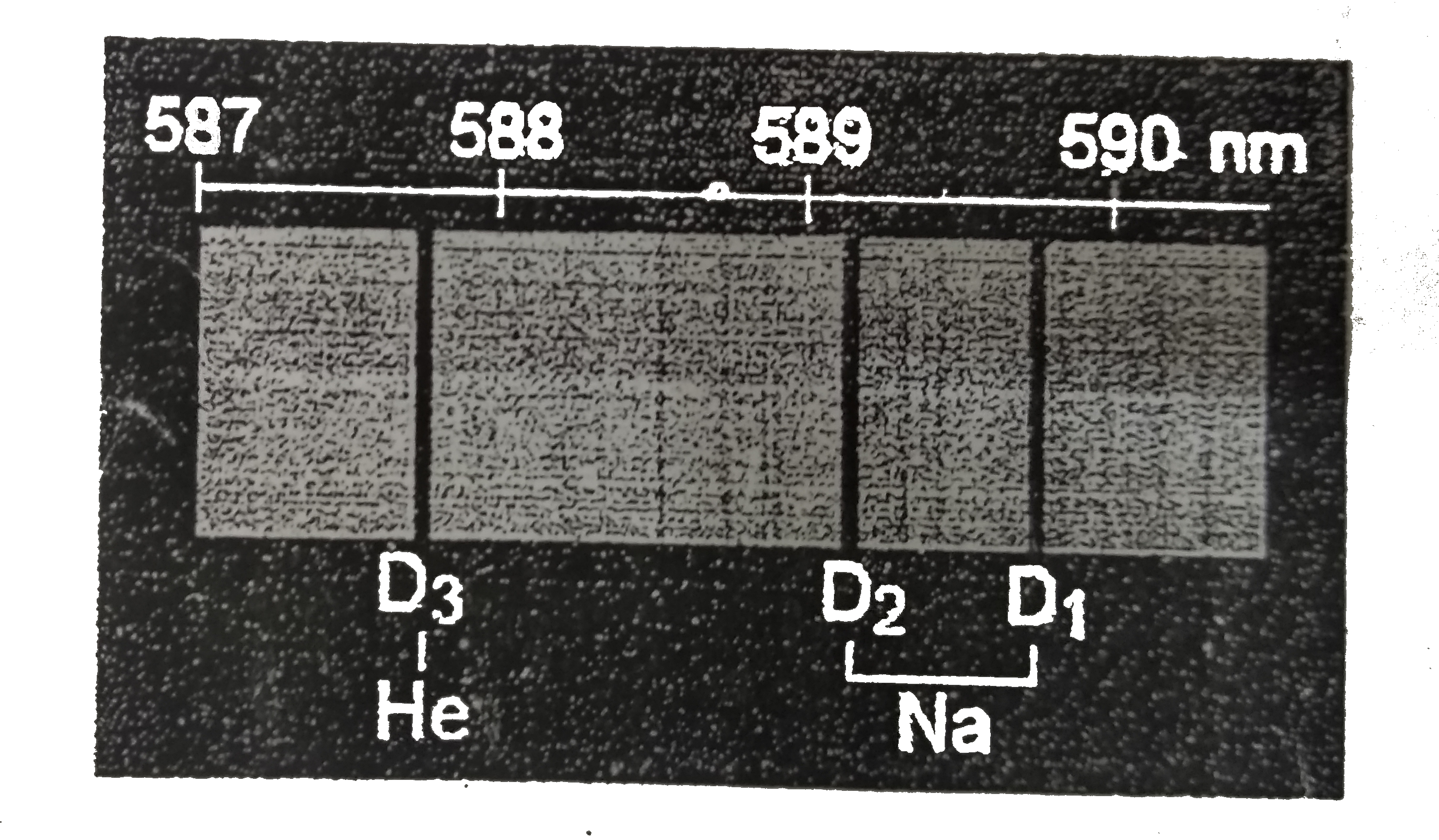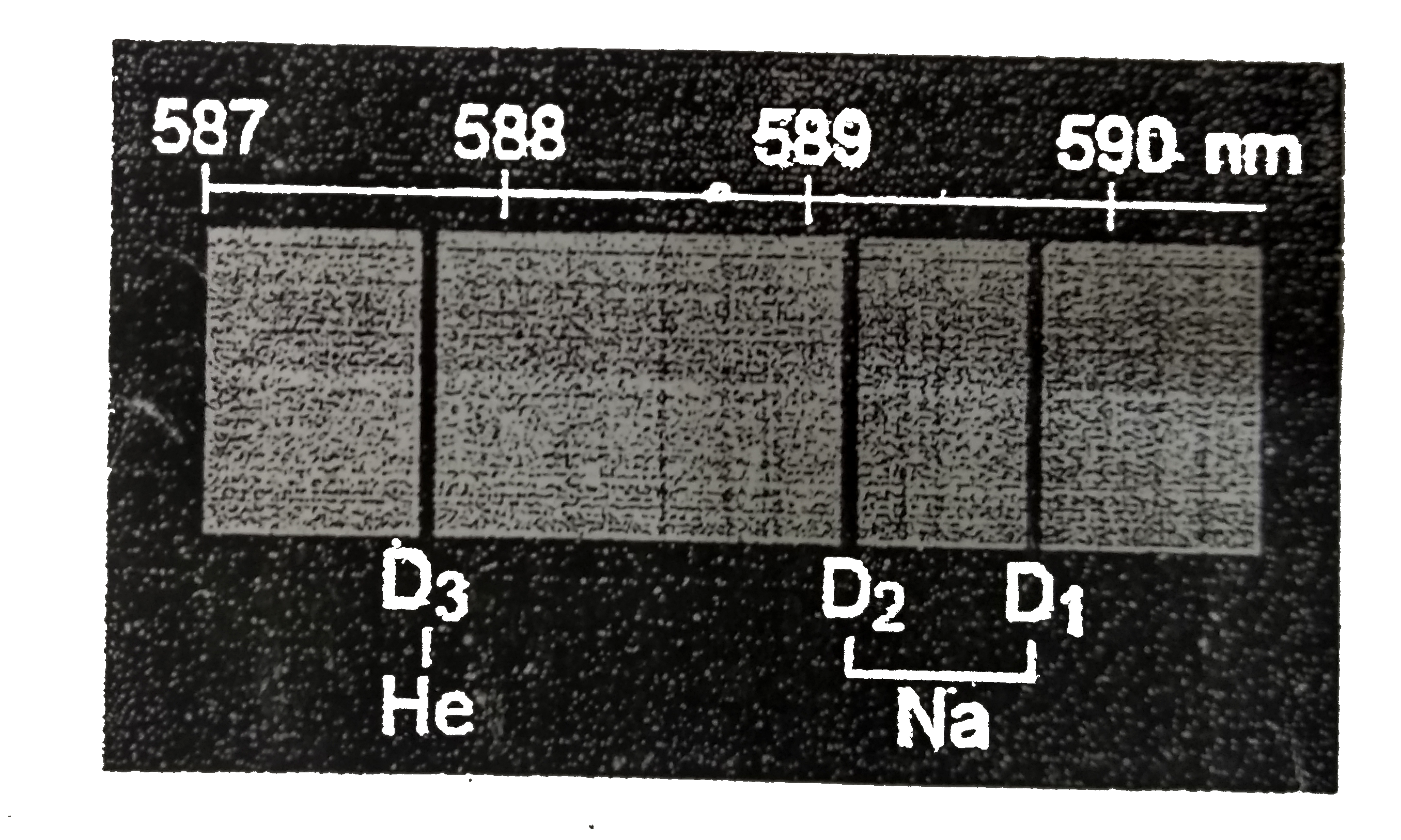Red hot carbon removes oxygen from the oxide XO and YO but not from ZO. Y will remove oxygen from XO. Use this evidence to deduce the order of activity of the three metals X, Y and Z putting the most active first.
X>Y>Z
Z>Y>X
Y>X>Z
Z>X>Y
The correct Answer is:B
To deduce the order of activity of the three metals X, Y, and Z based on the given information, we can follow these steps:
Step 1: Analyze the reactions involving carbon
- The problem states that red-hot carbon can remove oxygen from the oxides XO and YO, but not from ZO. This indicates that carbon is more reactive than both X and Y, but less reactive than Z.
Step 2: Establish the reactivity of metals based on carbon's ability to remove oxygen
- Since carbon can remove oxygen from XO, it implies that X is less reactive than carbon. Therefore, we can conclude that:
- Carbon > X
- Similarly, since carbon can also remove oxygen from YO, it implies that Y is also less reactive than carbon:
- Carbon > Y
Step 3: Determine the reactivity of Y and X
- The statement that Y can remove oxygen from XO indicates that Y is more reactive than X. Therefore, we can conclude that:
- Y > X
Step 4: Determine the reactivity of Z
- The fact that carbon cannot remove oxygen from ZO indicates that Z is more reactive than carbon. Thus, we can conclude that:
- Z > Carbon
Step 5: Combine the information to deduce the order of reactivity
- From the information gathered, we have:
- Z > Carbon > Y > X
- This means that the order of reactivity from most active to least active is:
- Z > Y > X
Final Order of Reactivity
- Therefore, the final order of activity of the metals is:
- Z (most active) > Y > X (least active)
- The problem states that red-hot carbon can remove oxygen from the oxides XO and YO, but not from ZO. This indicates that carbon is more reactive than both X and Y, but less reactive than Z.
- Since carbon can remove oxygen from XO, it implies that X is less reactive than carbon. Therefore, we can conclude that:
- Carbon > X
- Similarly, since carbon can also remove oxygen from YO, it implies that Y is also less reactive than carbon:
- Carbon > Y
- The statement that Y can remove oxygen from XO indicates that Y is more reactive than X. Therefore, we can conclude that:
- Y > X
- The fact that carbon cannot remove oxygen from ZO indicates that Z is more reactive than carbon. Thus, we can conclude that:
- Z > Carbon
- From the information gathered, we have:
- Z > Carbon > Y > X
- This means that the order of reactivity from most active to least active is:
- Z > Y > X
- Therefore, the final order of activity of the metals is:
- Z (most active) > Y > X (least active)
Topper's Solved these Questions
- ELECTROCHEMISTRYBOOK - VMC MODULES ENGLISHCHAPTER - ELECTROCHEMISTRYEXERCISE - EFFICIENT
46 Videos
- ELECTROCHEMISTRYBOOK - VMC MODULES ENGLISHCHAPTER - ELECTROCHEMISTRYEXERCISE - IMPECCABLE
50 Videos
- ELECTROCHEMISTRYBOOK - VMC MODULES ENGLISHCHAPTER - ELECTROCHEMISTRYEXERCISE - FUNDAMENTAL
50 Videos
- CLASSIFICATION OF ELEMENTS AND PERIODICITY IN PROPERTIES BOOK - VMC MODULES ENGLISHCHAPTER - CLASSIFICATION OF ELEMENTS AND PERIODICITY IN PROPERTIES EXERCISE - JEE ADVANCE (ARCHIVE)
30 Videos
- ENVIRONMENTAL CHEMISTRYBOOK - VMC MODULES ENGLISHCHAPTER - ENVIRONMENTAL CHEMISTRYEXERCISE - JEE Main (Archive)
39 Videos
Similar Questions
Red hot carbon will remove oxygen from the oxides XO and Yo but not from ZO.Y will remove oxygen from XO. Use this evidence to deduce the order of activity of the three metals X,Y, and Z, putting the most reactive first.
View SolutionA compound formed by elements X and Y has a cubic structure in which X atoms are at the corner of the cube and also at the face centers. Y atoms are present at the body centre and at the edge centre of the cube.
a. Celculate (i) Zeff' (ii) total number of atoms in the cube, and (iii) formula of the compound.
b. If all the atoms are removed from one of the body diagonals of the cube, calculate (i) Zeff' (ii) total number of atoms in the cube, and (iii) formula of the compound.
c. If all the atoms from the diagonals of the one of the face of the cube are removed, calculate (i) Zeff' (ii) total number of atoms in the cube, and (iii) formula of the compound.
d. If all the atoms are removed from one of the plane passing through the middle of t he cube, calculate (i) Zeff' (ii) total number of atoms in the cube, and (iii) formula of the compound.
e. If all the atoms are removed from one of the axes passing through one of the face centres of the cube, calculate (i) Zeff' (ii) total number of atoms in the cube, and (iii) formula of the compound.
View SolutionMetals are extracted from their ores by a wide variety of techniques. The most common ores are oxides. Most metals are obtained by direct treatment of theirs ores with chemical agents, but the extraction of certain others require electrolysis. An example of the former type of process is the extraction of iron from its oxide, described by the following equation :
Fe2O3+3C→2Fe+3CO
The relative ease of extraction of a metal from its oxide can be estimated using the Ellingham diagram, as shown in the figure.
The diagram plots the free energies of formation of various oxides per mole of consumed oxygen as a function of absolute temperature.

Which of the following best explains why the free energy of formation of Fe2O3 becomes less negative as the temperature is increased.
View SolutionRed light I(λ=664nm in vacuum) is used in Young's experiment with the slits separated by a distance from the screen given by D=2.75m. Find the distance y on the screen between the central bright fringe and the third-order bright fringe.
Reasoning: This problem can be solved by the first using Eq. (i) to determine the value of θ that locates the third-order bright fringe. Then, trigonometry can be used to obatin the distance y.
View SolutionWhen an atom or an ion is missing from its nomal lattice site a lattice vacanecy (Schottky defect) is created. In stoichmeteric ionic crystals, a vacancy of one ion has to be accompanied by the vacancy of the oppositely charge ion in order to maintain electrical neutrality.
In a Frenkel defect an ion leaves its position in the lattice and occupies an interstitial void. This id the Frenkel defect commonly found along with the Schottky defects and interstitial. In pure alkali halides. Frenked defects are not found since the ions cannot get into the interstitial sites. Frenkel defects are found in silver halides because of the small size of the Ag+ ion. Unike Schottky defects, Frenkel defect do not change the density of the solids. in certain ionic solids (e.g., AgBr) both schottky and Frenkel defect occur.
The Defects idiscussed above do not disturb the stoichiometery of the crystalline material. there is large variety of non-stoichiometric inorganic solids which contains an excess or deficienty of one of the elements. Such solids showing deviations from the ideal stoichiometric composition from an important group of solids. For example in the vanadium oxide, VOx,x can be anywehere between 0.6 and 1.3 there are solids such as difficult to prepare in the soichiometric omposition thus, the ideal composition in compounds such as FeO is difficult to obtain (normally we get a compositiion of Fe(0.95)O but it may range from Fe0.93O to Fe0.96O). Non-stoichiometric behavious is most commonly found for transition metal compounds through is also known for some lathanoids and actinoids.
Zinc oxide loses oxygen reversible at high temperature and turns yellow in colour. the excess metal is accomodated interstitial, giving rise to electrons trapped in the neighbourhood, the enchanced electrical conductivity of the non-stoichiometric ZnO arises from these electrons.
Anion vacancies in alkali halides are produced by heating the alkali halid crystals in an atmosphere of the alkali metal vapour. when the metal atoms deposit on the surface they diffuse into the cystal and after ionisation the alkali metal ion occupies cationic vacancy whereas electron occupies anionic vacancy. Electrons trapped i anion vacancies are referred to as F-centers (From Farbe the German word for colouf) that gives rise to interesting colour in alkali halides. Thus, the excess of potassium i KCl makes the crystal appear violet and the excess of lithium in LiCl makes it pink.
Which of the following is most appropritate crystal to show Frenkel defect ?
View SolutionA compound formed by elements X and Y has a cubic structure in which X atoms are at the corner of the cube and Y atoms are at the face centres. One atoms X is misssing from the corner.
a. Calculate (i). Zeff' (ii). total number of the atoms in the cube, and (iii). formula of the compound.
b. If alll the atoms are removed from one of the faces of the cube containing atoms at corners, as in (a) above, calculate (i) Zeff' (ii) total number of atoms in a cube, and (iii) formula of the compound.
View SolutionSilicon is the second most abundant element (~27.2%) in the earth's after oxygen (45.5%) Carbon. Silicon, germanium, tin and lead constitute the group 14 of the periodic table. Chemistry of silicon is distinctly different from that of carbon.
For example, under standard conditions CO2 is a gas whereas SiO2 is a covalent solid.
Group 14 elements have tendency to catenate. The first three members C,Si and Ge show significant catenation. Arrange these elements in decreasing order of their catenation tendency.
View SolutionIn 1894, Lord Rayleigh reported that the mass of chemically prepared nitrogen was different from that of nitrogen extracted from the atmosphere, as shown in Tables 1 and 2. Latter, this difference was attributed to the presence of argon in atmospheric nitrogen. The masses of gases were mearsured by using a glass vessel with a known volume under atmospheric pressure (1.013×105Pa).
∣∣ ∣ ∣ ∣ ∣ ∣ ∣∣From nitric oxide2.3001gFrom nitrous oxide2.2990gFrom amonium nitrite purified at a red heat2.2987gFrom urea2.2985gFrom ammonium nitrite purified in the cold2.2987gMean2.2990g∣∣ ∣ ∣ ∣ ∣ ∣ ∣∣
∣∣ ∣ ∣ ∣∣O2was removed by hot copper(1892)2.3103gO2was removed by hot iron(1893)2.3100gO2wasremovedbyferroushydrate(1894)2.3102gMean2.3102g∣∣ ∣ ∣ ∣∣
Ramsay and cleve discovered helium in cleveite (a mineral consiting of uranium oxide and oxides of lead, thorium, and rare earths, an impure variety of uraninite) independently and virtually simultaneously in 1895. The gas extracted from the rock showed a unique spectroscopic line at around 588 nm (indicated by D3 in Figure 1), which was fist observed in the spectrum of solar prominence during a total eclipse in 1868, near the well-known D1 and D2 lines of sodium.

Which––––––– equation explains the occurrence of helium in cleveite among [A] to [D] below? Mark one.
View SolutionIn 1894, Lord Rayleigh reported that the mass of chemically prepared nitrogen was different from that of nitrogen extracted from the atmosphere, as shown in Tables 1 and 2. Latter, this difference was attributed to the presence of argon in atmospheric nitrogen. The masses of gases were mearsured by using a glass vessel with a known volume under atmospheric pressure (1.013×105Pa).
∣∣ ∣ ∣ ∣ ∣ ∣ ∣∣From nitric oxide2.3001gFrom nitrous oxide2.2990gFrom amonium nitrite purified at a red heat2.2987gFrom urea2.2985gFrom ammonium nitrite purified in the cold2.2987gMean2.2990g∣∣ ∣ ∣ ∣ ∣ ∣ ∣∣
∣∣ ∣ ∣ ∣∣O2was removed by hot copper(1892)2.3103gO2was removed by hot iron(1893)2.3100gO2wasremovedbyferroushydrate(1894)2.3102gMean2.3102g∣∣ ∣ ∣ ∣∣
Ramsay and cleve discovered helium in cleveite (a mineral consiting of uranium oxide and oxides of lead, thorium, and rare earths, an impure variety of uraninite) independently and virtually simultaneously in 1895. The gas extracted from the rock showed a unique spectroscopic line at around 588 nm (indicated by D3 in Figure 1), which was fist observed in the spectrum of solar prominence during a total eclipse in 1868, near the well-known D1 and D2 lines of sodium.

Identify––––––––– the transition relevant to the D3 line of helium among the transitions [A] to [E] indicated in Figure 2. Mark one of the following:
[A] [B] [C] [D] [E]
View SolutionBorane is an electron deficient compound. It has only six valence eletons, so the boron atom lacks an octet. Acquiring an octet is the driving force for the unusual bonding structure found in boron compounds. As an electron deficient compound, BH3 is a strong electrophile, capable of adding to a double bond. This hydroboration of double bond is though to oC Cur in one step, with the boron atom adding to the less highly substituted end of the double bond. In transition state, the boron atom withdraws electrons from the pi bond and the carbon at theother end of the double bond acquires a partial positive charge. This positive charge is more stable on the more highly subsituted carbon atom. The second step is the oxidation of boron atom, removing it from carbon and replacing it with hydroxyl group by using H2O2/OH¯¯¯¯¯...
The simultaneous addition of boron and hydrogen to the double bond leads to a syn addition. Oxidation of the trialkyl borane replaces boron with a hydroxyl group in the same stereochemical position. Thus, hydroboration of alkenen is an example of steropecific reaction, in which different steroisomers of starting compounds react to give different steroisomers of the product.
_E01_056_Q01.png)
Y is :
View Solution
